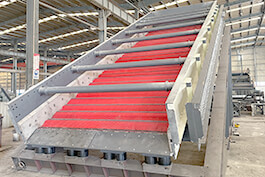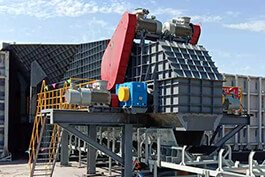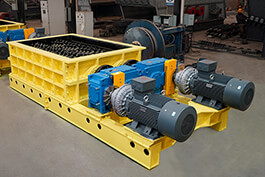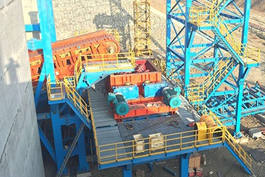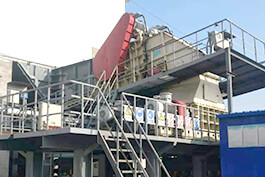Introduction
In market competition, the increase in production capacity often translates into significant cost advantages and an expansion of market share. The lifespan of the equipment is equally crucial. Frequent replacement of screening equipment not only leads to high equipment purchase costs but also causes production disruptions due to downtime for maintenance, resulting in incalculable economic losses.
Traditional screening equipment has gradually exposed many problems when facing complex working conditions and high-intensity operations, especially the wear problem of screen plates has become increasingly prominent. As the core component of the screening equipment, the screen plate is in direct contact with the materials and is subject to the impact, friction and various complex working conditions of the materials. The degree of its wear is directly related to the screening efficiency and the overall service life of the equipment. Flip Flow Screen, with its unique working principle and outstanding performance, brings new hope for solving the problems in the screening industry.
Comparison between Flip Flow Screen and traditional screening equipment
Wear and tear of traditional vibrating screens
The screen plates of linear screens mainly bear two types of wear during operation: sliding friction wear and impact wear.
Sliding friction wear is caused by the continuous friction between the material moving on the screen surface and the surface of the screen plate. When the material slides on the screen surface, each friction gradually wears away the material on the surface of the screen plate. This occurs throughout the entire working area of the screen plate, especially in the areas where the material movement paths are more concentrated, where the wear is more severe.
Impact wear occurs when materials strike the screen plate at a certain speed and Angle. When materials fall from a height, they have considerable kinetic energy. When they hit the screen plate, they will exert an instantaneous impact force on it, causing plastic deformation or even detachment of the material on the surface of the screen plate. This kind of impact wear is usually most obvious at the feeding end of the screen plate, as this is where the material first comes into contact with the screen plate and the impact force is also the greatest. Long-term impact wear can cause dents, cracks and other damages on the surface of the screen plate, seriously affecting its service life and screening effect.
Anti-wear of Flip Flow Screen
The Flip Flow Screen generates high-acceleration tensioning/relaxation motion through the secondary vibrator driving the screen plate. This motion mode is essentially different from the traditional vibrating screen.
When the Flip Flow Screen is working, during the tensioning stage, the screen plate is stretched and in a taut state. At this time, the material is subjected to a large force on the screen surface and moves forward rapidly. During the relaxation stage, the sieve plate instantly relaxes, and the material originally adhering to the sieve plate seems to be instantly thrown away by an invisible hand. This alternating movement significantly reduces the continuous sliding friction between the material and the edge of the screen holes.
When the screen plate is loose, the material is shaken off and no longer closely contacts the edge of the screen holes and generates friction, effectively reducing wear and significantly extending the service life of the screen plate. Compared with traditional vibrating screens, the anti-wear mechanism of Flip Flow Screen fundamentally reduces the occurrence of wear, providing a more efficient and durable solution for screening operations.
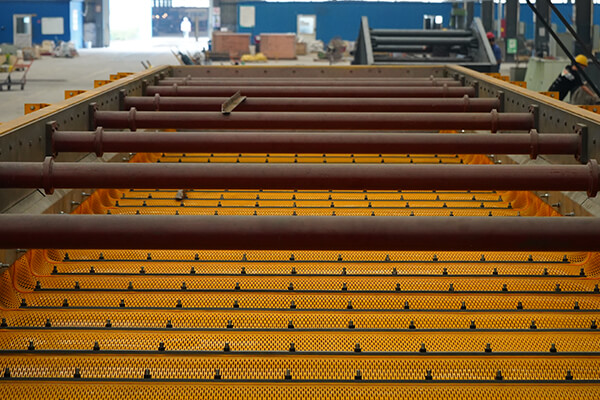
The material of the Flip Flow Screen sieve plate
Polyurethane
Polyurethane has extremely high elasticity and can undergo elastic deformation when impacted by materials, effectively absorbing and dispersing the impact force, thereby avoiding material damage caused by excessive local force.
Its wear resistance is also very outstanding, especially in resisting sliding friction. When the material slides on the surface of the screen plate, polyurethane, with its tough molecular structure, can effectively resist the wear of the material, greatly extending the service life of the screen plate.
Polyurethane also has excellent resistance to hydrolysis. Even in harsh working environments with high humidity and abundant water, it can effectively resist the erosion of water molecules and will not experience performance degradation due to hydrolysis. This characteristic further ensures the stability and reliability of the screen plate under complex working conditions.
Special rubber
In some specific and complex working conditions, screen plates made of special rubber materials can be selected.
When dealing with highly oily materials, ordinary materials are prone to erosion by oil substances, resulting in a decline in performance. Special rubber materials, through special formula design, can form stable interactions with oil substances at the molecular level, effectively resisting the erosion of oil and maintaining the stable performance of the screen plate.
When the screening environment is highly corrosive, the special additives in the special rubber materials can undergo chemical reactions with corrosive substances, forming a dense protective film on the material surface to prevent the corrosive substances from further penetrating into the interior of the material, thereby protecting the screen plate from corrosion. The application of this special rubber material enables Flip Flow Screen to find appropriate solutions when facing various complex working conditions, ensuring the smooth progress of the screening operation.
Hardness and toughness
When choosing the elastomer material of the Flip Flow Screen plate, Shore Hardness is an important parameter, which directly affects the wear of the screen plate.
If the hardness of the sieve plate is too high, the material will become relatively brittle and hard. When impacted by the material, it is prone to cracking, leading to damage of the sieve plate. On the contrary, if the hardness is too low, the screen plate will be overly soft. Under the friction and impact of the material, it is prone to deformation and wear, which will greatly shorten its service life.
Generally speaking, for Flip Flow Screen sieve plates, the appropriate Shore hardness range is usually within a specific interval. This interval enables the sieve plate to have both sufficient hardness to resist the wear of materials and good toughness to withstand the impact, thereby achieving a delicate balance between hardness and toughness and effectively extending the service life of the sieve plate.
The structural design of Flip Flow Screen
Modular design
The sieve plate is composed of multiple independent small sieve plates, which are combined together through a specific connection method to form a complete sieve surface.
When local wear occurs on the screen plate during operation, the traditional integral screen plate often requires the entire screen surface to be removed and replaced, which consumes a lot of manpower, material resources and time, and will also cause the equipment to be shut down for a long time, seriously affecting production efficiency. For modular screen plates, only the worn small screen plates need to be disassembled separately and new modules replaced, which greatly reduces maintenance costs, shortens downtime, and enables production to quickly return to normal.
Sieve hole design
The shape and arrangement of the sieve holes are important factors affecting the performance of the Flip Flow Screen sieve plate. The design of the sieve holes plays a key role in preventing material jamming and reducing wear.
The conical screen holes are wider at the top and narrower at the bottom, which can effectively prevent the material from getting stuck at the screen holes. When the material passes through the sieve holes, larger particles will be blocked when passing through the upper wide part, while smaller particles are more likely to pass through the lower narrow part, thus avoiding the material getting stuck in the sieve holes. In contrast, during the screening process of traditional straight-hole sieve plates, materials tend to accumulate and be squeezed at the edges of the sieve holes. This not only leads to clogging of the sieve holes and reduces the screening efficiency, but also accelerates the wear of the sieve plate due to the continuous friction and squeezing between the materials and the edges of the sieve holes.
The sieve plate of Flip Flow Screen undergoes high-frequency tensioning/relaxation movements during operation, and this movement keeps the sieve holes in a "breathing" state all the time. When the sieve plate is relaxed, the sieve holes will instantly expand, and the materials adhering to the surrounding sieve holes can be easily shaken off, thus achieving the self-cleaning function of the sieve holes and reducing material accumulation and local stress wear.
Connection reinforcement
The connection method between the support frame and the screen plate, a scientific and reasonable connection method can effectively reduce stress concentration and tear wear.
In Flip Flow Screen, special fasteners or wedge-shaped fixings and other methods are usually adopted to connect the support frame and the screen plate, which can effectively disperse and buffer the stress when the screen plate is subjected to high-frequency vibration. Special fasteners can provide a tighter connection and, at the same time, undergo certain elastic deformation under force, absorbing part of the stress. Wedge-shaped fixation takes advantage of the characteristics of the wedge-shaped structure. During installation, it can generate considerable friction, ensuring a tight fit between the screen plate and the support frame. Moreover, during vibration, the wedge-shaped structure can automatically adjust the force state, reducing stress concentration.
If the connection method is unreasonable, the edge of the screen plate will be subjected to greater stress under high-frequency vibration, which is prone to tearing and may cause damage to the screen plate. The connection method, which has been reinforced and buffered, can evenly distribute the stress on the screen plate, avoiding the problem of excessive local stress and effectively extending the service life of the screen plate.
The working condition adaptation of Flip Flow Screen
High-impact working condition
In some mining operations, raw ores often enter the screening equipment in large particle sizes. During the falling process of these large-sized materials, they exert a strong impact force on the screen plates. Under such high-impact and wear conditions, ordinary screen plate materials are difficult to withstand such high-intensity impacts, and are prone to damage and deformation, significantly shortening the service life of the screen plates.
The metal frame provides strong structural support for the screen plate, enhancing its overall strength. This enables the screen plate to maintain a stable shape and structure even when subjected to huge impact forces, preventing deformation and cracking.
High humidity/viscous working conditions
When the screened materials have high moisture content or viscosity, they tend to adhere to the surface of the screen plate, forming a thick adhesive layer. This will affect the screening efficiency and also intensify the "adhesive-dragging" phenomenon of the materials on the screen plate, thereby accelerating the wear of the screen plate.
The polyurethane Screen plate of Flip Flow Screen has a smooth surface. It is difficult for materials to adhere to its surface. Even if a small amount of materials adhere, the relaxation movement of Flip Flow Screen can easily solve this problem.
When the Flip Flow Screen is working, the high-frequency tensioning/relaxing movement of the screen plate causes the screen plate to have a strong "jitter", which can make the materials adhering to the screen plate lose adhesion and be easily shaken off, fundamentally eliminating the wear of "adhesive-dragging".
The wear resistance of Flip Flow Screen
Movement mechanism
The Flip Flow Screen completely breaks the mode of continuous contact and friction between the material and the screen plate of the traditional vibrating screen through the high-acceleration tensioning/relaxation motion driven by the secondary vibrator to the screen plate. During the relaxation stage, the material is instantly thrown away from the screen plate, significantly reducing the sliding friction between the material and the edge of the screen holes, and fundamentally lowering the occurrence of wear.
Material selection
Polyurethane, with its high elasticity, high wear resistance and excellent hydrolysis resistance, is the best choice for Flip Flow Screen plates. Effectively resist the impact and friction of materials to ensure that the screen plate maintains stable performance during long-term operation. For the special rubber materials used in special working conditions, through special formula design, the adaptability of Flip Flow Screen in complex environments has been further expanded, meeting the diverse needs of different industries.
Structural design
The modular design makes the replacement of the screen plate convenient, avoiding the situation where the entire screen surface is scrapped due to local wear, which greatly reduces maintenance costs and downtime. The conical sieve hole design effectively prevents material from getting stuck. Meanwhile, the self-cleaning feature brought by the relaxation movement keeps the sieve holes always unobstructed, reducing material accumulation and local stress wear. The reinforcement and buffering connection design between the support frame and the screen plate ingeniously disperses and buffers the stress generated by high-frequency vibration, preventing the tearing and wear of the screen plate edge and extending the overall service life of the screen plate.
Conclusion
The high wear resistance of the Flip Flow Screen plate has brought many significant economic benefits and production values to industrial production. The long service life of the sieve plate significantly reduces the downtime for equipment maintenance. Stable operation ensures the continuity and efficiency of production, and enhances the production capacity and efficiency of the enterprise. The Flip Flow Screen plate, with its outstanding anti-wear performance, has played an important role for enterprises in reducing costs and improving efficiency, and has become an indispensable key technology in the field of modern industrial screening.



